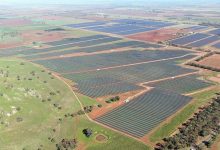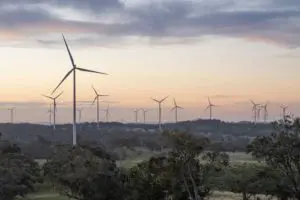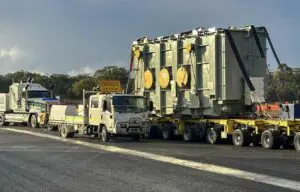The largest solar farm in New South Wales – the 300MW (AC) Walla Walla project north of Albury – won approval from the state’s planning commission on Friday, co-incidentally the day that the state’s new Renewable Infrastructure Roadmap came into force.,
The $400 million Walla Walla solar farm is being developed by the Saudi-owned FRV Services Australia, which keeps adding to its portfolio despite unconfirmed reports that its operating portfolio has been put up for sale, or is at least testing the market.
FRV says Walla Walla will be the company’s fifth solar development project in NSW (including the Goonumbla solar farm pictured above) – and its ninth in Australia. It will be the biggest in the state, although at 300MW it will likely be overtaken by other solar projects in coming years.
The project – located about 5kms north east of the locality of the same name – attracted opposition from some local residents, and the Greater Hume shire council, which led to its referral to the Independent Planning Commission.
The objections included the displacement of prime agricultural land, a potential “heat island” effect, biodiversity impacts, visual impacts on the surrounding landscape, and socio-economic impacts.
Colin Kane, the director of environment planning for Greater Hume Council, also expressed concern about battery storage at other nearby solar projects, which he told the IPC “can melt down like a nuclear reactor if they get too hot” and present problems for the largely volunteer local firefighting resources.
Other objections spokes of the risk of “heat and glare” that would be detrimental to humans and animals, the risk of burned wings on birds, and the use of toxic chemicals in solar panels. Most, however, centred on the use of productive farming land and visual amenity. Some objectors said solar panels are fine on rooftops, but not in paddocks.
Walla Walla is one of a number of solar farms proposed for the region, the others being Green Switch’s 120MW Jindera, Trina Solar’s 200MW Glenellen and Neoen’s 350MW Culcairn solar and battery project, just up the road from Walla Walla.
“After carefully considering all the evidence and weighing the community’s views, the Commission has … granted development consent for the solar farm, subject to conditions,” the IPC said in a statement. This includes completing a site rehabilitation program prior to the cessation of activities at the site.
The IPC decision was delivered on the same day as the NSW renewable roadmap came into force, having been passed earlier in the week in parliament after more than 30 continuous hours of debate. It will lead to the creation of renewable energy zones and up to $32 billion of new wind, solar and storage projects over the next decade.
FRV says the project will create around 250 construction jobs and will lift investment in local services such as fencing, civil works, land management, hospitality and accommodation. The estimated capital value of the project – $400 million – is 2.5 times more than the current annual construction output of the Riverina region.
“Walla Walla Solar Farm is a State Significant project by definition and we are very pleased we will now be able to proceed to private financing and construction given its potential to help NSW deliver quality new renewable energy infrastructure and transition away from fossil fuels,” the head of FRV Australia Carlo Frigerio said in a statement.
Frigerio acknowledged that while there had been opposition to the solar farm from some neighbours, broader community support for renewable energy projects was strong.










